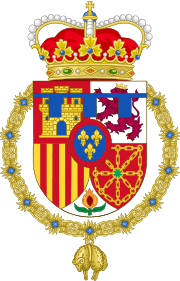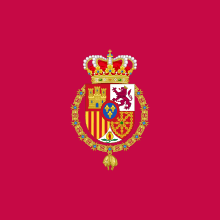Isabel II of Spain
Doña Isabel II (English: Isabella II; 10 October 1830 – 10 April 1904) was Queen of Spain from 1833 until 1868. She came to the throne as an infant, but her succession was disputed by the Carlists, who refused to recognize a female sovereign, leading to the Carlist Wars. After a troubled reign, she was deposed in the Glorious Revolution of 1868, and formally abdicated in 1870. Her son Alfonso XII became king in 1874.
Birth and regency

Isabel was born in Madrid in 1830, the eldest daughter of King Ferdinand VII of Spain, and of his fourth wife and niece, Maria Christina of Bourbon-Two Sicilies. Queen Maria Christina became regent on 29 September 1833, when her three-year-old daughter Isabel was proclaimed sovereign on the death of the king.
Isabel succeeded to the throne because Ferdinand VII had induced the Cortes Generales to help him set aside the Salic law, introduced by the Bourbons in the early 18th century, and to re-establish the older succession law of Spain. The first pretender, Ferdinand's brother Carlos, fought seven years during the minority of Isabel to dispute her title. Carlos' and his descendants' supporters were known as Carlists, and the fight over the succession was the subject of a number of Carlist Wars in the 19th century.
Isabel's reign was maintained only through the support of the army. The Cortes and the Moderate Liberals and Progressives reestablished constitutional and parliamentary government, dissolved the religious orders and confiscated their property (including that of Jesuits), and tried to restore order to Spain's finances. After the Carlist war, the regent, Maria Christina, resigned to make way for Baldomero Espartero, Prince of Vergara, the most successful and most popular Isabelline general. Espartero, a Progressive, remained regent for only two years.
Baldomero Espartero was turned out in 1843 by a military and political pronunciamiento led by Generals Leopoldo O'Donnell and Ramón María Narváez. They formed a cabinet, presided over by Joaquín María López y López. This government induced the Cortes to declare Isabel of age at 13.
Marriage
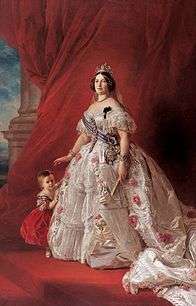
Three years later, on 10 October 1846, the Moderate Party (or Castilian Conservatives) made their sixteen-year-old queen marry her double-first cousin Francisco de Asís de Borbón (1822–1902), the same day that her younger sister, Infanta Luisa Fernanda, married Antoine d'Orléans, Duke of Montpensier.

The marriages suited France and Louis Philippe, King of the French, who as a result nearly quarrelled with Britain. However, the marriages were not happy; persistent rumour had it that few if any of Isabel's children were fathered by her king-consort, rumoured to be a homosexual. The Carlist party asserted that the heir-apparent to the throne, who later became Alfonso XII, had been fathered by a captain of the guard, Enrique Puigmoltó y Mayans.[1]
Isabel had nine children, but only five reached adulthood:
- Ferdinand (1850)
- Maria Isabel (1851–1931), Princess of Asturias, who married her mother's and father's first cousin Prince Gaetan, Count of Girgenti.
- Maria Cristina (1854)
- Alfonso XII (1857–1885)
- Maria de la Concepcion (1859–1861)
- Maria del Pilar (1861–1879)
- María de la Paz (1862–1946), who married her cousin Prince Ludwig Ferdinand of Bavaria.
- Francisco de Asis (1863)
- Eulalia de Asis de la Piedad (1864–1958), who married her cousin Infante Antonio, Duke of Galliera.
The couple was rather caustically described by an English contemporary thus:
- … The Queen is large in stature, but rather what might be called bulky than stately. There is no dignity either in her face or figure, and the graces of majesty are altogether wanting. The countenance is cold and expressionless, with traces of an unchastened, unrefined, and impulsive character, and the indifference it betrays is not redeemed by any regularity or beauty of feature.
- The King Consort is much smaller in figure than his royal two-thirds, and certainly is not a type that could be admired for its manly qualifications; but we have to remember that in Spain aristocratic birth is designated rather by a diminutive stature and sickly complexion than by those attributes of height, muscular power, open expression, and florid hue, which in England constitute the ideal of ‘race.’[2]
Reign as an adult
Isabel directly reigned from 1843 to 1868, a period of palace intrigues, back-stairs and antechamber influences, barracks conspiracies, and military pronunciamientos to further the ends of the political parties — Moderados who ruled from 1846 to 1854, Progressives from 1854 to 1856, and Unión Liberals from 1856 to 1863. Moderados and Unión Liberals quickly succeeded each other and kept out the Progressives, thus sowing the seeds for the Revolution of 1868.
Queen Isabel often interfered in politics. She showed favour to her reactionary generals and statesmen and to the Church and religious orders. Other events of her reign were the war against Morocco (1859), which ended in a treaty advantageous for Spain and cession of some Moroccan territory; the fruitless Chincha Islands War against Peru and Chile; tensions with the United States; independence revolts in Cuba and Puerto Rico; and some progress in public works, especially railways, and a slight improvement in commerce and finance. By virtue of a royal decree, she opened Iloilo to world trade on September 29, 1855 exporting mainly sugar and also other products to America, Australia and Europe. [3][4]
Exile and abdication

At the end of September 1868, Isabel went into exile, after her Moderado generals had made a slight show of resistance that was crushed at the Battle of Alcolea by Generals Serrano and Prim. This revolt, which deposed Isabel, is known as the Glorious Revolution, and ushered the First Spanish Republic into power. The new government replaced Isabel with Amadeo I, second son of Victor Emmanuel II of Italy, after much deliberation.
Her exile helped cause the Franco-Prussian War, as Napoleon III could not accept the possibility that a German, Prince Leopold of Hohenzollern-Sigmaringen, might replace Isabel, a dynast of the Spanish Bourbons and great-great-granddaughter of the French-born Philip V of Spain.
The First Spanish Republic collapsed in December 1874. Isabel had been induced to abdicate in Paris on 25 June 1870, in favour of her son, Alfonso XII, furthering the cause of the Restoration. After the collapse of the Republic, Alfonso was placed on the throne.
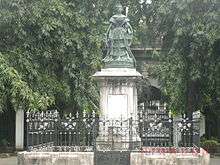
She had left her husband the previous March and continued to live in France after the restoration in 1874, in a small circle with the Marqués de Alta Villa as her secretary. On the occasion of one of her visits to Madrid during Alfonso XII's reign, she began to intrigue with the politicians of the capital, and was peremptorily requested to go abroad again. She resided in Paris for the rest of her life, seldom travelling abroad except for a few visits to Spain. During her exile, she grew closer to her husband, with whom she maintained an ambiguous friendship until his death in 1902. Her last days were marked by the matrimonial problems of her youngest daughter, Eulalia. She died on 10 April 1904, and is entombed in El Escorial.
Titles, styles and honours
Titles
- 10 October 1830 – 29 September 1833: Her Royal Highness The Princess of Asturias
- 29 September 1833 – 25 June 1870: Her Most Catholic Majesty The Queen of the Spains
- 25 June 1870 – 10 April 1904: Her Majesty Queen Isabel II of Spain
Styles
The underage Queen Isabel was known by the centuries-old feudal, symbolic, long title that included both extant and extinct titles and claims:
Isabel II by the Grace of God, Queen of Castile, Leon, Aragon, of the Two Sicilies, of Jerusalem, of Navarre, of Granada, of Toledo, of Valencia, of Galicia, of Majorca, of Seville, of Sardinia, of Córdoba, of Corsica, of Murcia, of Menorca, of Jaén, the Algarves, Algeciras, Gibraltar, the Canary Islands, of the East and West Indies, Islands and Mainland of the Ocean Sea; Archduchess of Austria; Duchess of Burgundy, Brabant, Milan and Aspurg; Countess of Flanders, Tirol and Barcelona; Lady of Biscay and Molina
In 1837, Spanish legislation produced a constitutional monarchy and a new format of the title was used for Isabel:
By the grace of God and the Constitution of the Spanish monarchy, Queen Isabel II of the Spains
Honours
National honours
-
 Spain: Former 16th Sovereign and 847th Knight with Collar of the Royal Spanish Order of the Golden Fleece[5][6][7][8][9]
Spain: Former 16th Sovereign and 847th Knight with Collar of the Royal Spanish Order of the Golden Fleece[5][6][7][8][9] -
 Spain: Former Sovereign Knight Grand Cross with Collar of the Order of Charles III[6][7][10][11][12][13][14]
Spain: Former Sovereign Knight Grand Cross with Collar of the Order of Charles III[6][7][10][11][12][13][14] -
 Spain: Former 4th Sovereign, Former 5th Grand Mistress and 562nd Dame Grand Cross of the Order of Queen Maria Luisa[6][7][15][16][17]
Spain: Former 4th Sovereign, Former 5th Grand Mistress and 562nd Dame Grand Cross of the Order of Queen Maria Luisa[6][7][15][16][17] -
 Spain: Former Sovereign Knight Grand Cross with Collar of the Order of Isabella the Catholic[18][19]
Spain: Former Sovereign Knight Grand Cross with Collar of the Order of Isabella the Catholic[18][19] -
 Spain: Knight Grand Cross with Collar of the Civil Order of Alfonso X
Spain: Knight Grand Cross with Collar of the Civil Order of Alfonso X -
 Spain: Former Sovereign Knight Grand Cross with Collar of the Royal Military Order of St. Hermenegild[20][21]
Spain: Former Sovereign Knight Grand Cross with Collar of the Royal Military Order of St. Hermenegild[20][21] -
 Spain: Former Sovereign Knight Grand Cross of the Order of Military Merit, 1st Class[20]
Spain: Former Sovereign Knight Grand Cross of the Order of Military Merit, 1st Class[20] -
 Spain: Former Sovereign Knight Grand Cross of the Order of Naval Merit, 1st Class[20]
Spain: Former Sovereign Knight Grand Cross of the Order of Naval Merit, 1st Class[20] -
 Spain: Former Sovereign Knight Grand Cross of the Royal Military Order of St. Ferdinand[6][20][22]
Spain: Former Sovereign Knight Grand Cross of the Royal Military Order of St. Ferdinand[6][20][22] -
 Spain: Former Sovereign Knight of the Royal Military Order of Calatrava
Spain: Former Sovereign Knight of the Royal Military Order of Calatrava -
 Spain: Former Sovereign Knight of the Royal Military Order of Santiago
Spain: Former Sovereign Knight of the Royal Military Order of Santiago -
 Spain: Former Sovereign Knight of the Royal Military Order of Alcántara
Spain: Former Sovereign Knight of the Royal Military Order of Alcántara -
 Spain: Former Sovereign Knight of the Royal Military Order of Montesa
Spain: Former Sovereign Knight of the Royal Military Order of Montesa
Foreign honours
-
.svg.png) Austria: Knight Grand Cordon with Collar of the Order of Saint Stephen of Hungary[23][24][25]
Austria: Knight Grand Cordon with Collar of the Order of Saint Stephen of Hungary[23][24][25] -
.svg.png) Austria: Dame of the Order of the Starry Cross, 1st Class[7][23][26][27]
Austria: Dame of the Order of the Starry Cross, 1st Class[7][23][26][27] -
.svg.png) Brazil: Knight Grand Cordon of the Imperial and Royal Order of Christ[23]
Brazil: Knight Grand Cordon of the Imperial and Royal Order of Christ[23] -
.svg.png) Brazil: Knight Grand Cordon with Collar of the Imperial and Royal Order of the Southern Cross[23]
Brazil: Knight Grand Cordon with Collar of the Imperial and Royal Order of the Southern Cross[23] - France
-
.svg.png) Bourbon-French Royal Family: Knight Grand Cross of the Royal Order of the Holy Spirit
Bourbon-French Royal Family: Knight Grand Cross of the Royal Order of the Holy Spirit -
.svg.png) Bourbon-French Royal Family: Knight Grand Cross with Collar of the Royal Order of Saint Michael
Bourbon-French Royal Family: Knight Grand Cross with Collar of the Royal Order of Saint Michael -
 French Imperial Family: Knight Grand Cordon with Collar of the Imperial Order of the Legion of Honour[23]
French Imperial Family: Knight Grand Cordon with Collar of the Imperial Order of the Legion of Honour[23]
-
-
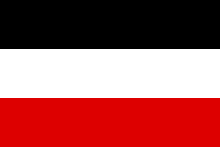 Germany
Germany
-
.svg.png) Bavaria: Knight Grand Cross with Chain of the Order of Saint Hubert[23]
Bavaria: Knight Grand Cross with Chain of the Order of Saint Hubert[23] -
.svg.png) Bavaria: Dame Grand Cross of the Order of Theresa[23]
Bavaria: Dame Grand Cross of the Order of Theresa[23] -
.svg.png) Bavaria: Dame Grand Cross of the Order of Saint Elizabeth[23]
Bavaria: Dame Grand Cross of the Order of Saint Elizabeth[23] -
.svg.png) Saxony: Knight Grand Cross of the Order of the Rue Crown[23][28]
Saxony: Knight Grand Cross of the Order of the Rue Crown[23][28] -
.svg.png) Saxony: Dame Grand Cross of the Order of Sidonia[23]
Saxony: Dame Grand Cross of the Order of Sidonia[23] -
.svg.png) Saxony: Dame of the Order of Maria-Anna, Special Class[23]
Saxony: Dame of the Order of Maria-Anna, Special Class[23]
-
-
.svg.png) Greece: Knight Grand Cross of the Order of the Redeemer[23]
Greece: Knight Grand Cross of the Order of the Redeemer[23] -
_crowned.svg.png) Italy: Knight Grand Collar of the Supreme Order of the Most Holy Annunciation[7]
Italy: Knight Grand Collar of the Supreme Order of the Most Holy Annunciation[7] -
_crowned.svg.png) Italy: Knight Grand Cordon of the Order of Saints Maurice and Lazarus
Italy: Knight Grand Cordon of the Order of Saints Maurice and Lazarus -
_crowned.svg.png) Italy: Knight Grand Cordon of the Order of the Crown of Italy
Italy: Knight Grand Cordon of the Order of the Crown of Italy
-
 Vatican
Vatican
-
 Holy See: Knight Grand Cross with Collar of the Supreme Order of Christ[23]
Holy See: Knight Grand Cross with Collar of the Supreme Order of Christ[23]
-
-
.svg.png) Two Sicilies: Knight Grand Cross with Collar of the Order of Saint Januarius[29]
Two Sicilies: Knight Grand Cross with Collar of the Order of Saint Januarius[29] -
.svg.png) Two Sicilies: Bailiff Knight Grand Cross with Collar of the Two Sicilian Sacred Military Constantinian Order of Saint George
Two Sicilies: Bailiff Knight Grand Cross with Collar of the Two Sicilian Sacred Military Constantinian Order of Saint George
-
-
.svg.png) Mexican Imperial Family: Knight Grand Cordon with Collar of the Imperial Order of Guadalupe[23]
Mexican Imperial Family: Knight Grand Cordon with Collar of the Imperial Order of Guadalupe[23] -
.svg.png) Mexican Imperial Family: Dame Grand Cordon of the Imperial Order of Saint Charles[23]
Mexican Imperial Family: Dame Grand Cordon of the Imperial Order of Saint Charles[23] -
 Monaco: Knight Grand Cross of the Order of Saint-Charles[23][30]
Monaco: Knight Grand Cross of the Order of Saint-Charles[23][30] -
.svg.png) Portugal: Knight Grand Cross of the Order of the Immaculate Conception of Vila Viçosa[23][31][32]
Portugal: Knight Grand Cross of the Order of the Immaculate Conception of Vila Viçosa[23][31][32] -
.svg.png) Portugal: Knight Grand Cross with Collar of the Order of the Tower and Sword[7][23][31]
Portugal: Knight Grand Cross with Collar of the Order of the Tower and Sword[7][23][31] -
.svg.png) Portugal: Dame Grand Cross of the Order of Saint Isabel[7][23][31]
Portugal: Dame Grand Cross of the Order of Saint Isabel[7][23][31]
Honorific Eponyms
-
 Philippines:
Philippines:
- Cavite: Bridge of Isabel II
- Isabela (province)
- Manila: El Banco Español Filipino de Isabel II former name of the current Bank of the Philippine Islands.
Ancestry
| Ancestors of Isabel II of Spain | ||||||||||||||||||||||||||||||||||||||||||||||||||||||||||||||||||||||||||||||||||||||||||||||||||||||||||||||||||||||||||||||||||||||||||||||||||||||||||||||||||||||||||||||||||||||||||||||||||||||||||||||||||||||||||||||||||||||||||||||||||||||||||||||||||||||||||||||||||||||||||||||||||||||||||||||||||||||||||||||||||||||||||||||||||||||||||||||||||||||||||||||||||||||||||||||||||||||||||||||||||||||||||||||||||||||||||||||||||||||||||||||||||||||||||||||||||||||||||||||||||||||||||||||||||||||||||||||||||
|---|---|---|---|---|---|---|---|---|---|---|---|---|---|---|---|---|---|---|---|---|---|---|---|---|---|---|---|---|---|---|---|---|---|---|---|---|---|---|---|---|---|---|---|---|---|---|---|---|---|---|---|---|---|---|---|---|---|---|---|---|---|---|---|---|---|---|---|---|---|---|---|---|---|---|---|---|---|---|---|---|---|---|---|---|---|---|---|---|---|---|---|---|---|---|---|---|---|---|---|---|---|---|---|---|---|---|---|---|---|---|---|---|---|---|---|---|---|---|---|---|---|---|---|---|---|---|---|---|---|---|---|---|---|---|---|---|---|---|---|---|---|---|---|---|---|---|---|---|---|---|---|---|---|---|---|---|---|---|---|---|---|---|---|---|---|---|---|---|---|---|---|---|---|---|---|---|---|---|---|---|---|---|---|---|---|---|---|---|---|---|---|---|---|---|---|---|---|---|---|---|---|---|---|---|---|---|---|---|---|---|---|---|---|---|---|---|---|---|---|---|---|---|---|---|---|---|---|---|---|---|---|---|---|---|---|---|---|---|---|---|---|---|---|---|---|---|---|---|---|---|---|---|---|---|---|---|---|---|---|---|---|---|---|---|---|---|---|---|---|---|---|---|---|---|---|---|---|---|---|---|---|---|---|---|---|---|---|---|---|---|---|---|---|---|---|---|---|---|---|---|---|---|---|---|---|---|---|---|---|---|---|---|---|---|---|---|---|---|---|---|---|---|---|---|---|---|---|---|---|---|---|---|---|---|---|---|---|---|---|---|---|---|---|---|---|---|---|---|---|---|---|---|---|---|---|---|---|---|---|---|---|---|---|---|---|---|---|---|---|---|---|---|---|---|---|---|---|---|---|---|---|---|---|---|---|---|---|---|---|---|---|---|---|---|---|---|---|---|---|---|---|---|---|---|---|---|---|---|---|---|---|---|---|---|---|---|---|---|---|---|---|---|---|---|---|---|---|---|---|---|---|---|---|---|---|---|---|---|---|---|---|---|---|---|---|---|---|---|---|---|---|---|---|---|---|---|---|---|---|---|---|---|---|---|---|---|---|---|---|---|---|---|---|---|---|---|---|---|---|---|---|---|---|---|---|---|---|---|---|---|---|---|---|---|---|---|---|---|---|---|---|---|---|---|---|---|---|---|---|---|---|---|---|---|
| ||||||||||||||||||||||||||||||||||||||||||||||||||||||||||||||||||||||||||||||||||||||||||||||||||||||||||||||||||||||||||||||||||||||||||||||||||||||||||||||||||||||||||||||||||||||||||||||||||||||||||||||||||||||||||||||||||||||||||||||||||||||||||||||||||||||||||||||||||||||||||||||||||||||||||||||||||||||||||||||||||||||||||||||||||||||||||||||||||||||||||||||||||||||||||||||||||||||||||||||||||||||||||||||||||||||||||||||||||||||||||||||||||||||||||||||||||||||||||||||||||||||||||||||||||||||||||||||||||
Film portrayal
In the 1997 film Amistad, she was played by Anna Paquin, and is depicted as a spoiled 11-year-old girl.
See also
- Carl Schurz, who was U.S. ambassador to Spain for a brief time at the beginning of Lincoln's presidency, in his Reminiscences (New York, McClure's Publ. Co., 1907, Volume II, Chapter VI) describes Isabel II and her court.
- Isabela province in the Philippines.
- Mid-19th-century Spain
- Spain under the Restoration
Further reading
- Barton, Simon. A History of Spain (2009) excerpt and text search
- Carr, Raymond, ed. Spain: A History (2001) excerpt and text search
- Esdaile, Charles J. Spain in the Liberal Age: From Constitution to Civil War, 1808–1939 (2000) excerpt and text search
References
| Wikisource has the text of the 1911 Encyclopædia Britannica article Isabella II. |
| Wikimedia Commons has media related to Isabella II of Spain. |
-
 This article incorporates text from a publication now in the public domain: Chisholm, Hugh, ed. (1911). "article name needed". Encyclopædia Britannica (11th ed.). Cambridge University Press.
This article incorporates text from a publication now in the public domain: Chisholm, Hugh, ed. (1911). "article name needed". Encyclopædia Britannica (11th ed.). Cambridge University Press.
- ↑ Juan Sisinio Pérez Garzón, Isabel II: Los Espejos de la Reina (2004)
- ↑ Mrs. Wm. Pitt Byrne, Cosas De España, Illustrative of Spain and the Spaniards as they are, Volume II, Page 7, Alexander Strahan, Publisher, London and New York, 1866.
- ↑ Demy Sonza. "The Port of Iloilo: 1855 - 2005". Graciano Lopez-Jaena Life and Works and Iloilo History Online Resource. Dr. Graciano Lopez-Jaena (DGLJ) Foundation, Inc..
- ↑ Henry Funtecha. "Iloilo's position under colonial rule". thenewstoday.info. Archived from the original on July 21, 2006..
- ↑ Wearing the Golden Fleece Necklet
- 1 2 3 4 Upload.wikimedia.org, Isabella wearing some Orders
- 1 2 3 4 5 6 7 Upload.wikimedia.org, Isabella wearing the honours
- ↑ "Image: madrazo1.jpg, (554 × 800 px)". 3.bp.blogspot.com. Retrieved 2015-09-23.
- ↑ "Isabelle II d Espagne en amzone - Equitation monte en amazone". eroschevauxpassion.over-blog.com. Retrieved 2015-09-23.
- ↑ https://c2.staticflickr.com/6/5456/9057988555_895a6e5803_b.jpg
- ↑ http://c7.alamy.com/comp/FF9KKM/isabella-ii-1830-1904-nqueen-of-spain-1833-1868-FF9KKM.jpg
- ↑ https://c4.staticflickr.com/4/3718/9060215330_a726e75c67.jpg
- ↑ https://40.media.tumblr.com/5428f5a7dd1423d399745d5a58a851a9/tumblr_nxq5g2BmH41t3ijnxo1_500.jpg
- ↑ https://36.media.tumblr.com/422a4260e9b6f63a74b2fe9dd23c5056/tumblr_n95vpnIbow1t3ijnxo1_500.jpg
- ↑ https://upload.wikimedia.org/wikipedia/commons/1/13/Isabel_II_niña.JPG
- ↑ http://c7.alamy.com/comp/EBREB5/isabella-ii-of-spain-as-a-child-1843-miguel-parra-abril-spain-spanish-EBREB5.jpg
- ↑ http://c7.alamy.com/comp/E1YH2E/queen-isabella-ii-by-bernando-lopez-piquer-1799-1874-spain-spanish-E1YH2E.jpg
- ↑ Isabella depicted wearing the order
- ↑ http://www.gogmsite.net/_Media/isabel-ii-photo-apfxkatenka-2.jpeg
- 1 2 3 4 c7.alamy.com, Isabella wearing her military Orders
- ↑ http://www.cult.gva.es/mbav/data/1087.jpg
- ↑ "Queen Isabel (Isabella) II of Spain and her family". forum.alexanderpalace.org. Retrieved 2015-09-23.
- 1 2 3 4 5 6 7 8 9 10 11 12 13 14 15 16 17 18 19 , VV. AA., Boletín de la Real Academia de la Historia, Tomo CLXXVI, Cuaderno I, 1979, Real Academia de la Historia, Madrid, España, páginas = 211 & 220, español, 6 de junio de 2010 Information Containing the Orders and Decorations received by Isabella II of her European tour after her coming of age to reign as Queen
- ↑ http://www.gogmsite.net/_Media/isabel-ii-by--location.jpeg
- ↑ "Image: Isabel-II_1858.jpg, (456 × 800 px)". 3.bp.blogspot.com. Retrieved 2015-09-23.
- ↑ http://www.almendron.com/artehistoria/wp-content/uploads/isabel-ii.jpg
- ↑ "Image: isabel_ii_de_espac3b1a.jpg, (800 × 1290 px)". hipnosnews.files.wordpress.com. Retrieved 2015-09-23.
- ↑ https://upload.wikimedia.org/wikipedia/commons/b/b6/Isabel_II_%28Segunda_parte_de_la_Guerra_Civil._Anales_desde_1843_hasta_el_fallecimiento_de_don_Alfonso_XII%29.jpg
- ↑ http://www.chivalricorders.org/bourbon/spain/brbspngn.htm
- ↑ http://media.cervantesvirtual.com/images/portales/reyes_y_reinas_espana_contemporanea/graf/textos/isabel_ii/isabel_18_s.jpg
- 1 2 3 gogmsite.com, Isabella wearing the Portuguese orders on one sash
- ↑ http://www.gogmsite.net/_Media/1842-isabel-ii-by-luis-2.png
External links
| Isabel II of Spain Cadet branch of the Capetian dynasty Born: 10 October 1830 Died: 10 April 1904 | ||
| Regnal titles | ||
|---|---|---|
| Preceded by Ferdinand VII |
Queen of Spain 1833 – 1868 |
Vacant Title next held by Amadeo |
| Spanish nobility | ||
| Vacant Title last held by Ferdinand (VII) |
Princess of Asturias 1830 – 1833 |
Succeeded by Isabella |

